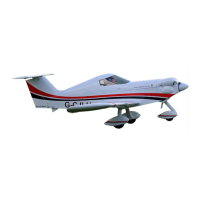
Do you have a question about the Spacek SD-1 Minisport TG and is the answer not in the manual?
Product liability disclaimer and operational risk warning for the SD-1 Minisport.
Defines the meaning of WARNING, CAUTION, and NOTE symbols used in the manual.
Details the SD-1 Minisport's construction as an ultra-light, low-wing monoplane.
Lists key measurements, weight, engine, and propeller specifications for the aircraft.
Provides details on the SE-33 engine and Helix H30F propeller.
Includes dimensional drawings of the aircraft for reference.
Specifies critical airspeed limits: VNE, VA, and VFE.
Explains the color-coded markings on the airspeed indicator.
Defines limits for wind speed during take-off and landing.
Lists operational limits for engine RPM, CHT, and oil temperature.
Covers maximum take-off weight, empty weight, and CG range.
Table for maximum fuel tank filling based on baggage and pilot weight.
Lists approved maneuvers and prohibited actions like aerobatics.
Details load factors for specific maneuvering speeds and control inputs.
Includes restrictions on smoking and performance in adverse weather.
Summarizes key airspeed limits and prohibited flight conditions.
Covers engine failure, smoke, fire, and landing emergencies.
Details procedures for emergency and precautionary landings.
Provides the standard procedure for recovering from an unintentional spin.
Describes how to assemble and disassemble aircraft components.
Emphasizes the importance and steps for a pre-flight inspection.
Details normal operating procedures and pre-takeoff checklists.
Checklists and safety warnings before starting the engine.
Procedure for starting the engine, including warm-up and ground testing.
Describes the landing procedure, including approach speeds and flap settings.
Provides take-off roll and distance over 15ft screen for grass and paved runways.
Gives landing distance from 50ft screen and landing roll for different runways.
Shows rate of climb and best rate of climb speed at different altitudes.
Details maximum horizontal speed, optimal cruise speed, and fuel consumption.
Specifies best glide speed and glide ratio.
Lists stall speeds for retracted and extended flaps.
Provides a calibration table for indicated airspeed vs. calibrated airspeed.
Details empty weight, CG movement, and allowed CG position range.
Describes the wood truss construction and dimensions of the fuselage.
Explains the composite spar and plywood construction of the wing.
Details the construction of the all-movable horizontal tail and fin.
Describes the fiberglass landing gear legs and braked wheels.
Explains how the horizontal tail, flaperons, flaps, and rudder are controlled.
Specifies the SE-33 engine and Helix H30F propeller.
Describes the integral fuel tank, valve, and fuel pump.
Details the aircraft's electrical system, battery, and charging.
Lists the installed flying instruments and their locations.
Information on the optional rescue system installation.
Provides specific deflection angles for rudder, elevator, and ailerons.
Introduction to recommended procedures for proper airplane operation.
Defines intervals for comprehensive inspections and maintenance.
Lists specific inspection tasks for the first 25 and 50 hours of service.
Details inspection tasks for the 100-hour or annual service interval.
Continues inspection tasks for the first 25 and 50 hours of service.
Continues inspection tasks for the 100-hour or annual service interval.
Details lubricants used and specific points for lubrication.